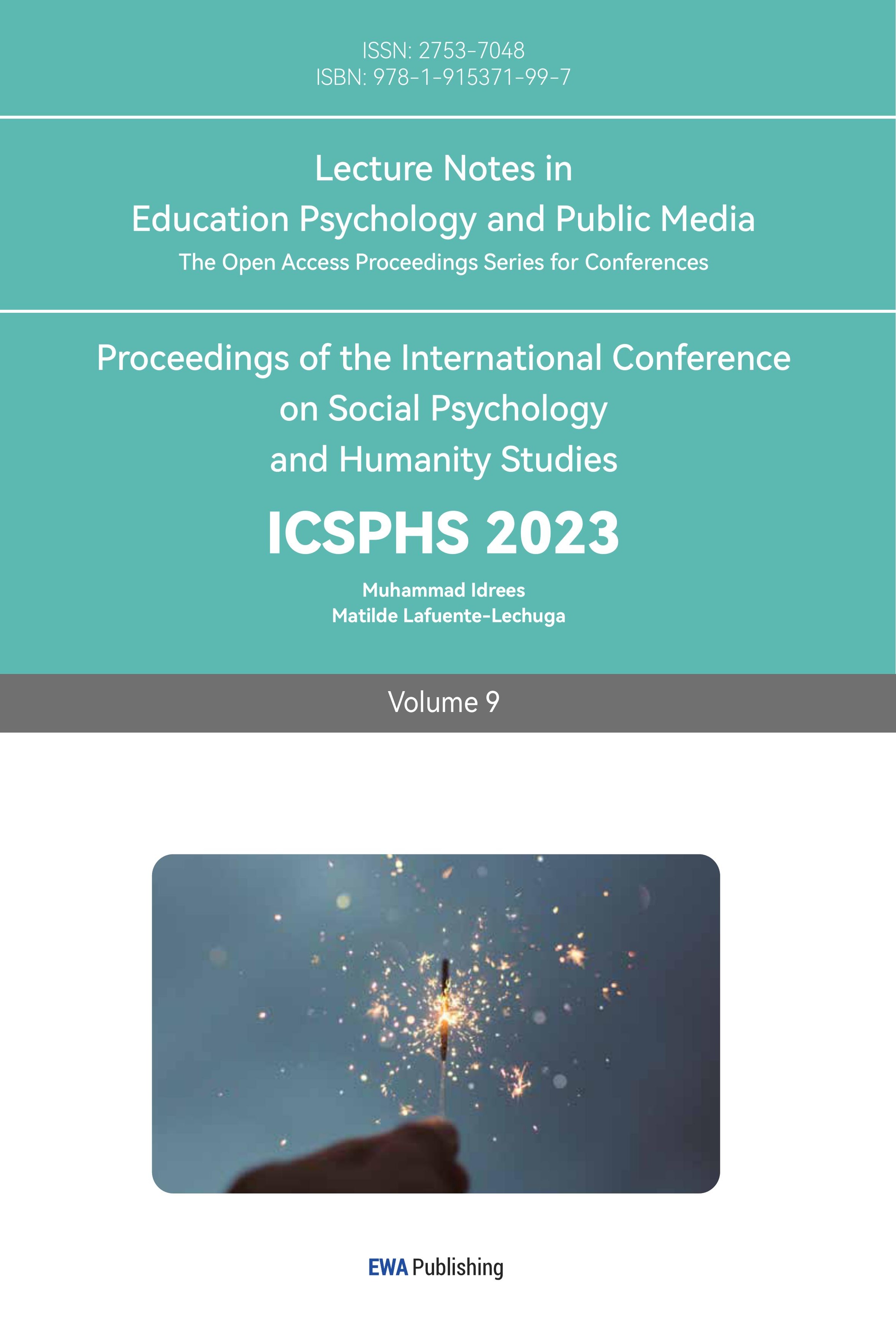References
[1]. Hazarika, Pratishi. (2020). The Quest to Reclaim the Lost Status of Hijras in India: A Reading of Living Smile Vidya’s I Am Vidya: A Transgender’s Journey and A. Revathi’s The Truth About Me: A Hijra Life Story. New Literaria. 1. 230-239. 10.48189/nl.2020.v01i2.019.
[2]. Hinchy, Jessica. (2019). Governing Gender and Sexuality in Colonial India: The Hijra , c.1850–1900. 10.1017/9781108592208.
[3]. Pal, S., Sinha, N. (2022). Employability Issues of Transgender Individuals in Gujarat, India: An Analysis of the Origin. In: Vakoch, D.A. (eds) Transgender India. Springer, Cham. https://doi-org-443--bjmu.hknsspj.cn/10.1007/978-3-030-96386-610
[4]. Khan, Mohammad Asif & Habiba, Umme. (2021). Exploring the Social Status with Psychoactive and Physical Impacts of HIJRA Community: An Evidence Based Study on Khulna City, Bangladesh. Asian Journal of Social Sciences and Legal Studies. 3. 1-9. 10.34104/ajssls.021.0109.
[5]. Sadiq, Shahida & Bashir, Aneeza. (2015). Relationship between perceived discrimination and depression: Moderating role of belief in just world among Transgender in Punjab. Journal of the Indian Academy of Applied Psychology. 41. 203-211.
[6]. Pattanaik D. (2014) Shikhandi: And Other Tales They Don't Tell You, Penguin Books Ltd.
[7]. Aggarwal, Aayushi. (2017). Hijras and their rights: in mythology and socio-cultural practises of India.
[8]. Piliavsky, Anastasia. (2015). The “Criminal Tribe” in India before the British. Comparative Studies in Society and History. 57. 323-354. 10.1017/S0010417515000055.
[9]. Al-Mamun, Md & Hossain, Md. Jamal & Alam, Morshed & Parvez, Md. Shahin & Dhar, Bablu & Islam, Md. (2022). Discrimination and social exclusion of third-gender population (Hijra) in Bangladesh: A brief review. Heliyon. 8. e10840. 10.1016/j.heliyon.2022.e10840.
[10]. Khan, Sharful & Hussain, et al. (2009). Living on the Extreme Margin: Social Exclusion of the Transgender Population (Hijra) in Bangladesh. Journal of health, population, and nutrition, (27):441-51. 10.3329/jhpn.v27i4.3388.
[11]. Goel, Ina. (2021) Understanding caste and kinship within hijras, a “third” gender community in India.
[12]. Chatterjee, I. (2002) “Alienation, Intimacy, and Gender: Problems for a History of Love in South Asia.” Queering India: Same-Sex Love and Eroticism in Indian Culture and Society, edited by Ruth Vanita, New York: Routledge, pp.61–76.
[13]. Islam, Sunjida. (2019). A Theoretical Analysis of the Legal Status of Transgender: Bangladesh Perspective.
Cite this article
Chu,H. (2023). A Comparison of the Hijra Transgender’s Social Status Between the Mughal Empire and the Post-colonial Era. Lecture Notes in Education Psychology and Public Media,9,404-408.
Data availability
The datasets used and/or analyzed during the current study will be available from the authors upon reasonable request.
Disclaimer/Publisher's Note
The statements, opinions and data contained in all publications are solely those of the individual author(s) and contributor(s) and not of EWA Publishing and/or the editor(s). EWA Publishing and/or the editor(s) disclaim responsibility for any injury to people or property resulting from any ideas, methods, instructions or products referred to in the content.
About volume
Volume title: Proceedings of the International Conference on Social Psychology and Humanity Studies
© 2024 by the author(s). Licensee EWA Publishing, Oxford, UK. This article is an open access article distributed under the terms and
conditions of the Creative Commons Attribution (CC BY) license. Authors who
publish this series agree to the following terms:
1. Authors retain copyright and grant the series right of first publication with the work simultaneously licensed under a Creative Commons
Attribution License that allows others to share the work with an acknowledgment of the work's authorship and initial publication in this
series.
2. Authors are able to enter into separate, additional contractual arrangements for the non-exclusive distribution of the series's published
version of the work (e.g., post it to an institutional repository or publish it in a book), with an acknowledgment of its initial
publication in this series.
3. Authors are permitted and encouraged to post their work online (e.g., in institutional repositories or on their website) prior to and
during the submission process, as it can lead to productive exchanges, as well as earlier and greater citation of published work (See
Open access policy for details).
References
[1]. Hazarika, Pratishi. (2020). The Quest to Reclaim the Lost Status of Hijras in India: A Reading of Living Smile Vidya’s I Am Vidya: A Transgender’s Journey and A. Revathi’s The Truth About Me: A Hijra Life Story. New Literaria. 1. 230-239. 10.48189/nl.2020.v01i2.019.
[2]. Hinchy, Jessica. (2019). Governing Gender and Sexuality in Colonial India: The Hijra , c.1850–1900. 10.1017/9781108592208.
[3]. Pal, S., Sinha, N. (2022). Employability Issues of Transgender Individuals in Gujarat, India: An Analysis of the Origin. In: Vakoch, D.A. (eds) Transgender India. Springer, Cham. https://doi-org-443--bjmu.hknsspj.cn/10.1007/978-3-030-96386-610
[4]. Khan, Mohammad Asif & Habiba, Umme. (2021). Exploring the Social Status with Psychoactive and Physical Impacts of HIJRA Community: An Evidence Based Study on Khulna City, Bangladesh. Asian Journal of Social Sciences and Legal Studies. 3. 1-9. 10.34104/ajssls.021.0109.
[5]. Sadiq, Shahida & Bashir, Aneeza. (2015). Relationship between perceived discrimination and depression: Moderating role of belief in just world among Transgender in Punjab. Journal of the Indian Academy of Applied Psychology. 41. 203-211.
[6]. Pattanaik D. (2014) Shikhandi: And Other Tales They Don't Tell You, Penguin Books Ltd.
[7]. Aggarwal, Aayushi. (2017). Hijras and their rights: in mythology and socio-cultural practises of India.
[8]. Piliavsky, Anastasia. (2015). The “Criminal Tribe” in India before the British. Comparative Studies in Society and History. 57. 323-354. 10.1017/S0010417515000055.
[9]. Al-Mamun, Md & Hossain, Md. Jamal & Alam, Morshed & Parvez, Md. Shahin & Dhar, Bablu & Islam, Md. (2022). Discrimination and social exclusion of third-gender population (Hijra) in Bangladesh: A brief review. Heliyon. 8. e10840. 10.1016/j.heliyon.2022.e10840.
[10]. Khan, Sharful & Hussain, et al. (2009). Living on the Extreme Margin: Social Exclusion of the Transgender Population (Hijra) in Bangladesh. Journal of health, population, and nutrition, (27):441-51. 10.3329/jhpn.v27i4.3388.
[11]. Goel, Ina. (2021) Understanding caste and kinship within hijras, a “third” gender community in India.
[12]. Chatterjee, I. (2002) “Alienation, Intimacy, and Gender: Problems for a History of Love in South Asia.” Queering India: Same-Sex Love and Eroticism in Indian Culture and Society, edited by Ruth Vanita, New York: Routledge, pp.61–76.
[13]. Islam, Sunjida. (2019). A Theoretical Analysis of the Legal Status of Transgender: Bangladesh Perspective.









